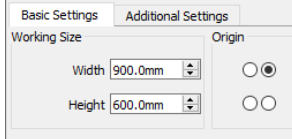That’s an absurdly long pulse for a 40 W CO₂ tube. My 60 W machine gives a good scorch with 50 ms at 50%.
Which strongly suggests the tube is on its last legs.
That’s a Bad Sign™ I hoped you wouldn’t find. A long discussion of what’s going on has more details:
The mirrors are badly in need of alignment, with the spot at M3 being so far off-center the beam may be splashing inside the nozzle and creating a second burn beside the main focus spot.
You may as well go through the whole mirror alignment process, just for practice. This discussion covers some key details:
If the thing still burns a double dot with the beam going right down the middle or it still requires tens of seconds to get the job done, then it’s in need of a new tube.
There are two places for that. The first is telling the controller the platform size, which should already be correct. To check, go to Edit → Machine Settings in the Vendor Settings sections for the X and Y axes. I don’t know what verbiage your (oddball) controller will use, but the manual says:
scope: it means the farthest distance that the motion axle can move, which is determined in accordance with the actual condition of the machine.
The label on the back of the cabinet says 600×450, so set those for the X and Y axes, respectively. I expect they are already correct, but now we both know.
Then you set the LightBurn working size to match, which happens in Edit → Device Settings:
Leave that dialog open, because …
When you turn the machine on, it should home to one corner of the platform and stop. If it doesn’t home properly, then there’s another problem to fix.
Assuming it behaves properly, then go to Edit → Device Settings and click the Origin dot corresponding to that corner. The machine in the sample above homes to the rear right corner (as does mine), although anything is possible.
Some of that is due to the double-dot problem, but a large part comes from not having the Scanning Offset Adjustment set up.
You’ve got enough on your to-do list right now, so let’s not open that particular can-o-worms. ![]()
